Lord Muck's Blog
January 29, 2018
I killed my hens a few days ago. I’m not in the habit of doing this;  I’m very fond of hens and have been keeping them for getting on for 20 years (and indeed kept them as a child), but if you look after them properly they grow old and stop laying eggs. Actually that isn’t quite true. The first hens I had were Warrens the breed created for the intensive laying industry. They are pretty easy to obtain and they are bred to lay and lay and lay for a couple of years and then die. That’s the economic model of the industry. Why pay for the feed and housing of hens that don’t lay? Being new to the game I didn’t know this when I got them. When they predictably, died, I got some pure breeds, a White Sussex a Barred Plymouth Rock and a Rhode Island Red from memory. They were lovely and lived to a great age, ten, not laying an egg between them for about the last two years of their lives and only about 50-60 a year for a couple of years before that. Actually they might well have lived a while longer, but they made the ultimate sacrifice and final contribution to the household economy and after I’d killed them they ended up in the pot. So most recently in 2012 I set off again to the Domestic Fowl Trust then still based outside Pershore for three more. These were crosses of various kinds including a Speckeldy, some kind of Plymouth Rock cross and some kind of Sussex. Six years later the time came round again for the killing spree. No eggs laid since about September and no sign despite the lengthening days, of any more to come. Two more (the third one died about three years ago after being severely frightened by a fox) to add to the statistics – which in the UK alone is in excess of 600 million hens a year slaughtered – yes really. That statistic kind of summarises my position on this. As a vegetarian for the past almost 40 years I’d be a lot a happier about meat eating if people slaughtered it themselves (road kill allowed). I think that might reduce meat consumption quite a bit, helping both the planet and peoples wallets and carbon footprint. To say nothing of animal welfare. But I digress.
I’m very fond of hens and have been keeping them for getting on for 20 years (and indeed kept them as a child), but if you look after them properly they grow old and stop laying eggs. Actually that isn’t quite true. The first hens I had were Warrens the breed created for the intensive laying industry. They are pretty easy to obtain and they are bred to lay and lay and lay for a couple of years and then die. That’s the economic model of the industry. Why pay for the feed and housing of hens that don’t lay? Being new to the game I didn’t know this when I got them. When they predictably, died, I got some pure breeds, a White Sussex a Barred Plymouth Rock and a Rhode Island Red from memory. They were lovely and lived to a great age, ten, not laying an egg between them for about the last two years of their lives and only about 50-60 a year for a couple of years before that. Actually they might well have lived a while longer, but they made the ultimate sacrifice and final contribution to the household economy and after I’d killed them they ended up in the pot. So most recently in 2012 I set off again to the Domestic Fowl Trust then still based outside Pershore for three more. These were crosses of various kinds including a Speckeldy, some kind of Plymouth Rock cross and some kind of Sussex. Six years later the time came round again for the killing spree. No eggs laid since about September and no sign despite the lengthening days, of any more to come. Two more (the third one died about three years ago after being severely frightened by a fox) to add to the statistics – which in the UK alone is in excess of 600 million hens a year slaughtered – yes really. That statistic kind of summarises my position on this. As a vegetarian for the past almost 40 years I’d be a lot a happier about meat eating if people slaughtered it themselves (road kill allowed). I think that might reduce meat consumption quite a bit, helping both the planet and peoples wallets and carbon footprint. To say nothing of animal welfare. But I digress.
My friend Premier came round to help. She was originally from Zimbabwe and learned to slaughter, pluck, gut and joint chickens from the age of ten. So she knew what to do. We killed one each. Pretty quick, pretty easy, but her method was more elegant.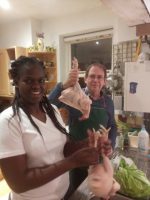 My experience is just once every 5-6 years. Mind you the phrase ‘headless chicken’ hasn’t passed into the language for no reason. They really do flap around, and if you gave them the chance, run about for a good minute or so. Stone dead, but looking alarmingly alive. Prepping them up for the pot was an eye opener – I’ve always avoided this part of the process in the past. Plucking is made much easier by pouring very hot water over them – the feathers come out real easy then (actually I knew this part as I’d read about it in novels like Edna O’Brien’s ‘The country girls’ – life in the west of Ireland in the 1950’s). Gutting them is a real skill; I wasn’t going anywhere near this part, definitely not ‘Blue Peter’ try-this-one-at-home style. Premier managed to extract all the offal and separated it away for consumption; heart, liver, kidney, gizzard, the lot, with of course the sole exception of the gall bladder which she carefully cut out – bursting that and you spoil the lot. Then to the jointing. Even here nothing is lost. The legs are descaled, and the feet are removed and kept – presumably for soup, there isn’t anything else on them. Ditto the head. Bones are broken and legs, wings and rib cage are reduced to manageable sizes.
My experience is just once every 5-6 years. Mind you the phrase ‘headless chicken’ hasn’t passed into the language for no reason. They really do flap around, and if you gave them the chance, run about for a good minute or so. Stone dead, but looking alarmingly alive. Prepping them up for the pot was an eye opener – I’ve always avoided this part of the process in the past. Plucking is made much easier by pouring very hot water over them – the feathers come out real easy then (actually I knew this part as I’d read about it in novels like Edna O’Brien’s ‘The country girls’ – life in the west of Ireland in the 1950’s). Gutting them is a real skill; I wasn’t going anywhere near this part, definitely not ‘Blue Peter’ try-this-one-at-home style. Premier managed to extract all the offal and separated it away for consumption; heart, liver, kidney, gizzard, the lot, with of course the sole exception of the gall bladder which she carefully cut out – bursting that and you spoil the lot. Then to the jointing. Even here nothing is lost. The legs are descaled, and the feet are removed and kept – presumably for soup, there isn’t anything else on them. Ditto the head. Bones are broken and legs, wings and rib cage are reduced to manageable sizes. 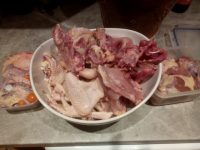 Thirty minutes or so later there was 2.5kg of edible (in one form or another) chicken from each bird and waste amounting to half a cup full from the pair of them. Now that is the way to honour their lives. Thank you dear hens; you were great company, an ornament in the garden, delightfully productive in your lives, and equally so in your deaths. May your souls soar and when I come to eat you I will raise a glass to your memory.
Thirty minutes or so later there was 2.5kg of edible (in one form or another) chicken from each bird and waste amounting to half a cup full from the pair of them. Now that is the way to honour their lives. Thank you dear hens; you were great company, an ornament in the garden, delightfully productive in your lives, and equally so in your deaths. May your souls soar and when I come to eat you I will raise a glass to your memory.
November 23, 2017
One of the reasons I like plants so much is that they don’t move. They might sway in the wind, spread across paving, or clamber up trellises, but you know where to find them. With reasonable eyesight you can spot even the smallest ones and take your time identifying them or appreciating them as the spirit moves you. The same can’t be said of birds, and that is why I’m not a ‘birder’. They do annoying things like perch high up in inaccessible trees, on telegraph lines, or in bushes. They even hide in their nests or the bird box I so thoughtfully provide in the crab apple tree. Worse still if you approach them they often fly away. When did a plant last do that? But this doesn’t mean I don’t appreciate birds. A murmuration of starlings is one of the wonders of the natural world. Robins have sweet personalities and are great company for an afternoons digging. The sight of a raptor, especially a large on like a red kite, gliding on the thermals of a warm day effortlessly scanning the ground for prey (or abandoned kebabs if in a city) is a thing of beauty. Blue tits, swallows or blackbirds nesting are a delight, and not so unusual. But my identification skills either by sight or call are pretty poor. I’m an expert at a dozen – seagull, rook, owl – either you know where to look – rookery, seashore, landfill site; or their call – ‘de-wit de-woo’ is distinctive enough not to be mistaken for something else.
So it has been with great joy that over the past few weeks I have been able to extend my range of recognisable garden birds. To my considerable amazement an unknown to me, bird of some size has been a regular visitor to the garden. I’ve enjoyed being able to watch it from the window of my study, strutting over the grass and taking the occasional peck at the ground – worm? insect? remains of Snicker Bar buried by a squirrel? Trying to photograph this lovely visitor proved too big a challenge – too far away, no suitable lens and a tendency for the thing to fly away when approached – did I mention that? But I did have time for a good look and a consult of my ‘Complete Garden Bird Book’. And the big reveal? Its a Green Woodpecker. 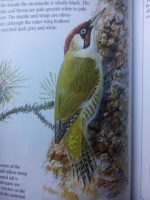 Not so rare, ‘a large sturdy woodpecker found throughout most of Europe’ is how its range is described, but new to my garden for sure. Its nice to know it thinks my garden is sufficiently wooded to be an attractive habitat, and according to the book it is probably after ants when poking its long beak into my lawn. Some day soon at this rate I will be able to identify two dozen birds. Will that make me a ‘birder’ after all?
Not so rare, ‘a large sturdy woodpecker found throughout most of Europe’ is how its range is described, but new to my garden for sure. Its nice to know it thinks my garden is sufficiently wooded to be an attractive habitat, and according to the book it is probably after ants when poking its long beak into my lawn. Some day soon at this rate I will be able to identify two dozen birds. Will that make me a ‘birder’ after all?
October 8, 2017
I love to go exploring for interesting fruit and vegetable growing, and produce markets of all sorts when on holiday. Lord and Lady Muck’s recent visit to the Dalmatian Coast – mostly Croatia but also a little bit of Bosnia (the tragedy of the 1990’s civil war is still raw, but that is another story) included admiring hill side beehives above Makarska (and trying the local honey), exploring narrow valleys amongst the karst limestone mountains and checking out what grows well on the tiny patches carved out of unremitting rock and shored up with intricate terraces and winding cascades of steps. Olives, cherries, figs, almonds, oranges and lemons on the more distant terraces; aubergines tomatoes, vines, cabbages and other brassicas nearer to the front door.
So it was with some delight that we came across the ‘ 11th Croatian Festival of Jams and Marmalades’ last weekend in Dubrovnik. Its aimed at tourists of course (thought Dubrovnik is a lot quieter by early October) but this doesn’t preclude some fascinating conversations and opportunities to sample the stall holders wares. Take Made Jakobusic and her daughter from Petraca, a small village 10 km south of Dubrovnik up in the mountains near the Bosnian border. The family has been farming in the village for over 200 years. One of their main products is olive oil. Their groves were seriously damaged in a fire in 1983 and again by invading Serbian forces in the ‘Homeland War’ in 1991, but have since recovered. Though now they have to get the oil processed in a mill 60 km up the coast at Ston. Its too complicated to pop a few kilometres over the border into Bosnia – Croatia is in the EU, Bosnia isn’t. Figs are the other main product with some fifty fig trees. They grow the small blue ones.
11th Croatian Festival of Jams and Marmalades’ last weekend in Dubrovnik. Its aimed at tourists of course (thought Dubrovnik is a lot quieter by early October) but this doesn’t preclude some fascinating conversations and opportunities to sample the stall holders wares. Take Made Jakobusic and her daughter from Petraca, a small village 10 km south of Dubrovnik up in the mountains near the Bosnian border. The family has been farming in the village for over 200 years. One of their main products is olive oil. Their groves were seriously damaged in a fire in 1983 and again by invading Serbian forces in the ‘Homeland War’ in 1991, but have since recovered. Though now they have to get the oil processed in a mill 60 km up the coast at Ston. Its too complicated to pop a few kilometres over the border into Bosnia – Croatia is in the EU, Bosnia isn’t. Figs are the other main product with some fifty fig trees. They grow the small blue ones.  ‘They are designed for drying’ says Made, ‘They have thicker skins that allow the fruit to remain juicy and soft in side when dry. We wash them in seawater and dry them in the open air and the wind of the bora.’ Oranges, lemons and some 30 almond trees complete the picture. As well as olive oil their product range includes fig jam, fig salami and fig cake, dried figs, orange jam (so-called marmalade), and loads of items preserved in sugar.
‘They are designed for drying’ says Made, ‘They have thicker skins that allow the fruit to remain juicy and soft in side when dry. We wash them in seawater and dry them in the open air and the wind of the bora.’ Oranges, lemons and some 30 almond trees complete the picture. As well as olive oil their product range includes fig jam, fig salami and fig cake, dried figs, orange jam (so-called marmalade), and loads of items preserved in sugar.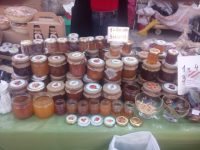 We depart with sugared almonds, dried figs and candied orange peel in our bag.
We depart with sugared almonds, dried figs and candied orange peel in our bag.
The previous week, exploring the mountains above Makarska, we luxuriated in the autumnal bounty, admiring the terraces almost toppling over with vines, figs, cherries, walnuts and olives tended by their elderly but very fit owners. ‘When I retire I’d like to do something like that’ say I to Lady Muck, ‘But you are retired she says’ (some hope!). And anyway I reflect, I already have vines, cherries, figs and walnuts in garden or allotment. So all I need now is an olive tree.
August 30, 2017
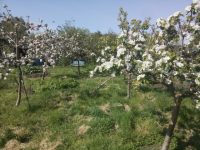 Blimey, the season of mists and mellow fruitfulness has arrived early this year! Its still August and the apple harvest is well ready. And what a harvest it is. The most abundant apple crop I’ve seen in years, if not ever. Not so surprising remembering the abundant blossom. Some apple varieties don’t hang about either. Its been good eating the James Grieve over the past couple of weeks, but others like Lord Lambourne are coming down the track, and already the James Grieve are beginning to look a little ‘over the hill’; they bruise easily and as soon as they are ripe the birds go for them. So rather than waste them its time to get local apple juice company Tiddly Pommes in to harvest them. I did this first in 2013 when I broke my shoulder in a bike accident and couldn’t harvest them anyway, but I soon realised what delicious juice they make, and it doesn’t go off unlike the apples – at least not for 18 months.
Blimey, the season of mists and mellow fruitfulness has arrived early this year! Its still August and the apple harvest is well ready. And what a harvest it is. The most abundant apple crop I’ve seen in years, if not ever. Not so surprising remembering the abundant blossom. Some apple varieties don’t hang about either. Its been good eating the James Grieve over the past couple of weeks, but others like Lord Lambourne are coming down the track, and already the James Grieve are beginning to look a little ‘over the hill’; they bruise easily and as soon as they are ripe the birds go for them. So rather than waste them its time to get local apple juice company Tiddly Pommes in to harvest them. I did this first in 2013 when I broke my shoulder in a bike accident and couldn’t harvest them anyway, but I soon realised what delicious juice they make, and it doesn’t go off unlike the apples – at least not for 18 months.
So here we were, Rupert Griffin and Lord Muck on a rather misty morning, stripping the tree of all that fruit.  Rupert who founded Tiddly Pommes several years ago is not only an apple expert but a great engineer who loves to improvise, and developed a pressing and bottling business in his back garden. Its gone well and is now installed in the abandoned glass houses where Oxford City Council used to raise all the bedding plants for its ‘Britain in Bloom’ Award winning displays (I remember visiting them when I chaired the relevant committee as a councillor back in the 1980’s). Public sector cuts have seen to that – its all contracted out now, but at least the greenhouses have been re-purposed. Today is a good day for harvesting James Grieve because the convent on Fairacres Road has three trees and they can all be pressed in sequence without the need to clean out the machinery. He is off there next. Actually Rupert really likes to keep varieties separate. Customers, whether they be local restaurants, deli’s or farmers market clients, like to buy a pure juice; ‘Apple juice,variety unknown’ doesn’t have much of a market (if that’s your thing try Tesco, who last time I looked, were marketing theirs with the come-on ‘Serve lovely and cool’, not like the horrible and cool stuff all the other supermarkets flog of course).
Rupert who founded Tiddly Pommes several years ago is not only an apple expert but a great engineer who loves to improvise, and developed a pressing and bottling business in his back garden. Its gone well and is now installed in the abandoned glass houses where Oxford City Council used to raise all the bedding plants for its ‘Britain in Bloom’ Award winning displays (I remember visiting them when I chaired the relevant committee as a councillor back in the 1980’s). Public sector cuts have seen to that – its all contracted out now, but at least the greenhouses have been re-purposed. Today is a good day for harvesting James Grieve because the convent on Fairacres Road has three trees and they can all be pressed in sequence without the need to clean out the machinery. He is off there next. Actually Rupert really likes to keep varieties separate. Customers, whether they be local restaurants, deli’s or farmers market clients, like to buy a pure juice; ‘Apple juice,variety unknown’ doesn’t have much of a market (if that’s your thing try Tesco, who last time I looked, were marketing theirs with the come-on ‘Serve lovely and cool’, not like the horrible and cool stuff all the other supermarkets flog of course).
Last years target was 10,000 bottles. Rupert said rather gleefully as we picked away, ‘We made it just, 10,001.’ So my 30-40 bottle contribution seems like pretty small beer. But neighbours have contributed similar quantities of apples; Henrietta’s Worcester’s and Elizabeth’s Grenadier’s are both from garden trees in Divinity Road. Favourite apple? ‘Adams Permain’ says Rupert without missing a beat.
It shouldn’t take long to see the results; a small number of free bottles, and as many more as I like at ‘trade price’. As for the rest? Rupert has them for sale, so when you are next at a farmers market in Oxford, or eating out, try some. Lord Muck will be entertaining guests with a few bottles in the coming months; the sweet aromas and tangy joys of those James Grieve’s will live on accompanying some of the other produce of this glorious season.
July 3, 2017
Its been a weekend for harvesting soft fruit and variously freezing it, making jam – oh joy some gooseberry jam is now safely stowed in the cellar after several years of eking out a very limited supply; daughter Nadine and I share a particular delight in homemade gooseberry jam. And making summer pudding. Well Wimbledon does start today and its so much nicer than strawberries, with cream. Ah, summer pudding making. A very long tradition in the Muck household. When children were small and time tight, getting it all made before the fruit went off in the heat, and the pressures of school nights – home work supervision, PE kit assembly and the like, meant cutting corners. In a nice way of course. One of these – most obvious when the puddings came out of the freezer some autumn evening, was the presence of what came to be known as ‘fruit bones’. 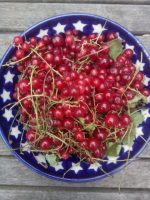 Yes the sheer joyful laziness of chucking the redcurrants into the boiling mixture still on their stalks, rather than faffing around laboriously picking off each tiny berry. The compromises of parent hood. The don’t improve a summer pudding, but like small bones in a fish, they go with the territory. You can pick them out, choose to eat them, or a bit of both. Just like fish bones. Hence the name – invented here. I know its not Robert Macfarlane’s shtick, but when he’s finished his successor book to ‘Landmarks’, maybe he will turn his attention to those quirky words for culinary activities. ‘Fruit bones’ will surely be ripe for inclusion.
Yes the sheer joyful laziness of chucking the redcurrants into the boiling mixture still on their stalks, rather than faffing around laboriously picking off each tiny berry. The compromises of parent hood. The don’t improve a summer pudding, but like small bones in a fish, they go with the territory. You can pick them out, choose to eat them, or a bit of both. Just like fish bones. Hence the name – invented here. I know its not Robert Macfarlane’s shtick, but when he’s finished his successor book to ‘Landmarks’, maybe he will turn his attention to those quirky words for culinary activities. ‘Fruit bones’ will surely be ripe for inclusion.
May 29, 2017
A few days ago I was sitting in my lovely new garden room having had the French windows open all day with all this warm weather, and was talking on the phone to Lady Muck, when all of a sudden out from under the sofa opposite a pair of tiny, dark, beady eyes appeared.  And then another pair. Field mice. As I talked, these two ran across the room and back under the sofa again, only to re-appear somewhere else like characters from behind the arras in an Elizabethan play. It was only when I’d finished the conversation that I was able to assume my own part in their play – ‘Exeunt, pursued by a bear’. I was charmed, and it brought to mind my encounters with a frog the previous Sunday. I was prepping up to open my garden to the public as part of the Divinity Road Residents Association Open Garden (or more accurately ‘lets be nosy in our neighbours gardens’) scheme. I was advertising mine as organic, strong on composting, climate resilient, wildlife friendly….that kind of thing; so moving a bag of grit out of the way of visitors and finding a frog beneath was a very pleasant surprise. Frogs, tadpoles, bumble bees and honey bees, nesting birds (blue tits in the nest box), field mice, squirrels (they appeal to the visitors, but not to me);
And then another pair. Field mice. As I talked, these two ran across the room and back under the sofa again, only to re-appear somewhere else like characters from behind the arras in an Elizabethan play. It was only when I’d finished the conversation that I was able to assume my own part in their play – ‘Exeunt, pursued by a bear’. I was charmed, and it brought to mind my encounters with a frog the previous Sunday. I was prepping up to open my garden to the public as part of the Divinity Road Residents Association Open Garden (or more accurately ‘lets be nosy in our neighbours gardens’) scheme. I was advertising mine as organic, strong on composting, climate resilient, wildlife friendly….that kind of thing; so moving a bag of grit out of the way of visitors and finding a frog beneath was a very pleasant surprise. Frogs, tadpoles, bumble bees and honey bees, nesting birds (blue tits in the nest box), field mice, squirrels (they appeal to the visitors, but not to me);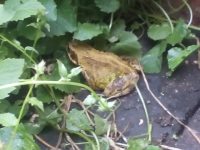 there was some sign of success, though I’m sad to say I haven’t seen or heard, a hedgehog for about a decade.
there was some sign of success, though I’m sad to say I haven’t seen or heard, a hedgehog for about a decade.
The visitors, some 40 over the afternoon, were impressed; several remarked that the garden didn’t feel ‘manicured’ like many others (the wildlife wouldn’t like that and I’m not into ‘outdoor housework’, I struggle enough with the indoor variety). The things they were most impressed with otherwise? That the garden isn’t flat but has different levels – at least in part a reflection of the fact that its built on a hill, and the arch with clematis and honey suckle growing over it. Coming through the side shed it is the first thing they saw in the garden, and it made more of an impression on them that it generally does on me. The range and variety of pots and statuary around the hen house impressed too, including the water barrel and guttering system for collecting rainwater off the hen house roof. Of course that is for reasons of hen security as much as for aesthetics; foxes, and there are a few, are definitely one aspect of the local wildlife I do not cherish!
May 21, 2017
It is a year since I took up my post as Chair of Garden Organic, and this week was the first time I had to preside over an AGM. It sounds like it could be the most tedious aspect of the entire role, but far from it. The event is something Garden Organic has always taken seriously – after all it is a membership organization and its Trustees are elected by and from the membership. So inviting them along and giving them a good time (as well as telling them about the grisly details of the finances) goes with the territory. And the ‘territory’ this year? Doddington Hall just outside Lincoln. It is a grand Elizabethan pile built in 1595, still in private ownership, with a set of facilities ideal for a gathering of organic gardeners. Apart from a conference hall suitable for 120+, approximately the number of members who came along, an excellent cafe (and the inevitable retail therapy opportunities which along the predictable ‘farm shop’ and ‘country clothing’ outlet, included a bike shop) it has a delightful garden (only open to the public twice a week during the summer months, but available to peer into through wrought iron gates at other times) and a two acre walled Victorian kitchen garden.  More on that later. The assembled members were entertained by Garden Organic’s CEO James Campbell clad in a vivid lime green jacket, President Prof Tim Lang, whose ‘Unfolding agenda for Garden Organic’ ranged widely across everything from the risks of using fossil fuel-based fertilisers in a world where fossil fuels are increasingly scarce, to our ability to actually harvest the food we grow post Brexit, if the migrant labour isn’t there to do it. Commenting that we have an opportunity to unleash a rethinking of the food system, he urged us to ‘love the present crisis.’ And finally, Chris Collins, Head of Organic Horticulture, and former BBC ‘Blue Peter’ gardener, whose talk on Food Growing Schools in London project was by turns inspiring, laughter inducing and a dose of sheer common sense.
More on that later. The assembled members were entertained by Garden Organic’s CEO James Campbell clad in a vivid lime green jacket, President Prof Tim Lang, whose ‘Unfolding agenda for Garden Organic’ ranged widely across everything from the risks of using fossil fuel-based fertilisers in a world where fossil fuels are increasingly scarce, to our ability to actually harvest the food we grow post Brexit, if the migrant labour isn’t there to do it. Commenting that we have an opportunity to unleash a rethinking of the food system, he urged us to ‘love the present crisis.’ And finally, Chris Collins, Head of Organic Horticulture, and former BBC ‘Blue Peter’ gardener, whose talk on Food Growing Schools in London project was by turns inspiring, laughter inducing and a dose of sheer common sense.
But in a way this was all a prelude to the garden tour. What a treat it was being taken round by the head Kitchen Gardener, James Mellors  (a wonderfully Lawrentian stately home-ish name). The garden itself was only restored from desolation a decade ago, thanks to a Heritage Lottery Fund grant and the expert input of the ‘Lost Gardens of Heligan’ team. Now a team of five gardeners – deployed across the whole estate, has turned it into an organic marvel. Top fruit and soft fruit trained up the walls, including gooseberries climbing to six feet, asparagus beds like I’ve never managed – the secret seems to be the sandy soil – not clay like mine, a line of runner bean poles that is so huge it looks more like a Civil War stockade, quantities of broad beans whose pinched-out tops we were told were in the salads in the cafe that day, and parsnips that Chris Collins admired while confessing that ‘buttered parsnips’ were his favourite vegetable.
(a wonderfully Lawrentian stately home-ish name). The garden itself was only restored from desolation a decade ago, thanks to a Heritage Lottery Fund grant and the expert input of the ‘Lost Gardens of Heligan’ team. Now a team of five gardeners – deployed across the whole estate, has turned it into an organic marvel. Top fruit and soft fruit trained up the walls, including gooseberries climbing to six feet, asparagus beds like I’ve never managed – the secret seems to be the sandy soil – not clay like mine, a line of runner bean poles that is so huge it looks more like a Civil War stockade, quantities of broad beans whose pinched-out tops we were told were in the salads in the cafe that day, and parsnips that Chris Collins admired while confessing that ‘buttered parsnips’ were his favourite vegetable.
And this was to say nothing of the magnificent greenhouse with the merlot grapes and lemon tree, the biggest cold frame I have ever seen, 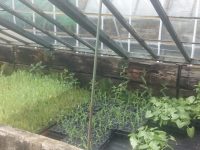 and a set of compost bins, the heart of any organic garden of course, which our CEO James Campbell described as being ‘the size of my garden’ – well, certainly big enough to park an SUV in – indeed one did have an SUV parked in it!
and a set of compost bins, the heart of any organic garden of course, which our CEO James Campbell described as being ‘the size of my garden’ – well, certainly big enough to park an SUV in – indeed one did have an SUV parked in it!  Said bins were located remarkably close to the church, but if you have your own church in the grounds I guess you can put whatever you like next to it.
Said bins were located remarkably close to the church, but if you have your own church in the grounds I guess you can put whatever you like next to it.
To round off the day an ‘organic gardeners question time’ panel (not including me, I’m not expert enough) fielded questions from a highly informed audience. Questions like ‘What should I do with dandelions on an acre of lawn?’ The questioner was clearly angling for some kind of organic ‘magic bullet’ as an alternative to spraying them, but of course the panel took a completely different approach, suggesting that the obvious answer is to leave them there; as a supply of leaves for hens (I can confirm their love of them) or tortoises, for salad (of course), and the flowers for the bees and as the basis for dandelion wine. And dammit, just because they are pretty. With advice like that dispensed with such authority and good humour, who could argue with James Campbell’s (still in ‘that jacket’) concluding remark that Garden Organic membership at ‘less than the cost of a pint per month’ was a refreshment to savour.
May 12, 2017
It rained last night. That wouldn’t sound like such an amazing statement in the normal course of events in England. But its been dry, very dry, for a couple of months. It has rained occasionally, but April’s rainfall in southern England has been no more than 20% of normal and that has itself followed an unusually dry winter. Though not a cold winter – no snow at all this year, there were enough consistent and hard frosts in December and January to see off garden pests that thrive in warm winters – hopefully.
From my perspective the only consolation about this dry weather has been that at this time of the year evaporation levels are relatively low – the water in the soil by and large stays there. Helped of course by plenty of compost, muck and mulch. Thank you chickens, thank you compost heap. It has also been rather cold. Some sunny days, but chilly quite a lot of the time. Drought doesn’t necessarily mean hot sunshine.
 But on a more positive note what an impact this has had on spring blossom. Several weeks of sunny, still and dry weather brought the blossom out – rather alarmingly early perhaps, and then temperatures plunged, the weather stayed calm, and the blossom bloomed and stayed blooming. Doesn’t the allotment look beautiful! Apart from a few late blossoming apple varieties, it has mainly gone over now, but the fruit crop has set – thank you bees – and assuming we now get some decent rain we could be in for a bumper fruit crop this year. Updates through the season.
But on a more positive note what an impact this has had on spring blossom. Several weeks of sunny, still and dry weather brought the blossom out – rather alarmingly early perhaps, and then temperatures plunged, the weather stayed calm, and the blossom bloomed and stayed blooming. Doesn’t the allotment look beautiful! Apart from a few late blossoming apple varieties, it has mainly gone over now, but the fruit crop has set – thank you bees – and assuming we now get some decent rain we could be in for a bumper fruit crop this year. Updates through the season.
March 9, 2017
Sitting at home last weekend watching the driving rain and the wind throwing everything around including the felting on my hen coop roof – a decisive prod to replace it this spring, reminded me of the old adage about March, ‘…comes in like a lion and goes out like a lamb’. It certainly came in like a lion this year. But I’d chopped enough wood for the fire and it seemed like a final opportunity to read about gardens rather than work in one. And what a treat in store to read and look at.
Last summer I was nosing round the book fair in the Bristol Passenger Shed – dozens of stalls all incredibly diverse in their offers, and came across one selling the library of the late Enid Marx, wood engraver and ‘pattern maker’ extraordinaire. She died in 1998 and she gifted her work and library to the V&A; with the generous caveat that they could sell off those parts of her library they didn’t want (the archive is now housed at Compton Verney, in Warwickshire). A bookseller had picked up all those parts of the library and had them for sale. Amongst the many treasures was Clare Leighton’s book ‘Four Hedges; a gardeners chronicle’. Published in 1935 by Victor Gollancz, Clare was herself a remarkable wood engraver and writer. I snapped up the book, first edition, Enid Marx’s copy (!) and quite well-thumbed, battered even – with various personalised additions including a couple of Clare Leighton obits (she died in 1989), a hand designed ‘happy new year’ bookmark, and various annotations. Clearly a book that meant something its owner.
Reading it, its not hard to see why. ‘Four Hedges’ is a large format book which chronicles Clare and her partner Noel’s work on their garden near Princes Risborough in the Chilterns. It is divided into twelve chapters one for each month and starts in the Spring running April to March.  Its a diary and series of reflections on the joys and sorrows of gardening, and the specific challenges of a garden ‘..perched on a slope of the Chiltern Hills, exposed to every wind that blows’. As she puts it ‘Dig into it just one spit and you reach as it were, a solid cement foundation. One might be hacking at the white cliff of Dover.’ But not only has she produced a wonderful chronicle of the garden, but no less than 86 absolutely beautiful wood engravings. No wonder the book is still in print.
Its a diary and series of reflections on the joys and sorrows of gardening, and the specific challenges of a garden ‘..perched on a slope of the Chiltern Hills, exposed to every wind that blows’. As she puts it ‘Dig into it just one spit and you reach as it were, a solid cement foundation. One might be hacking at the white cliff of Dover.’ But not only has she produced a wonderful chronicle of the garden, but no less than 86 absolutely beautiful wood engravings. No wonder the book is still in print.
Being early March I turned to that chapter to see how she felt about the weather and gardening while I was slacking in front of a log fire. Appropriately she starts by saying, ‘We have just visited some friends in a sheltered garden in Oxfordshire. As we went in at the gate we moved forward fully a month. Here were flowers in full blossoming: anenomes, daffodils, scylla, cyclamen and hepaticas clustered warm and still. I come back to our garden full of apologies to our struggling wind blown buds.’ But not to be put off she re-frames the experience; ‘Perhaps we are after all to be envied for the lateness of our seasons. Is it not like the privilege of hearing over again music that has come to its end? I have had the pleasure of seeing spring flowers in our friends garden and now I can travel back in time and watch the annual unfolding of buds.’ It reminds me of my trip to Iceland in 2013, visiting the Botanic Gardens in Akureyri on the north coast of that island in late July, and finding all the flowers of spring and early summer flowering in profusion. Joyous and dislocating at the same time.
Winter, as we know is a time for poring over seed and bulb catalogues, fantasizing about the wonders of the garden in the spring and summer and spending too much money. Strange to say Clare Leighton is no different. January includes a confession that brings a rush of empathy, ‘It is a terrible weakness to take as much pleasure as we do in bulb and tree and seed catalogues. Bulb catalogues, especially are wonderful ‘dope’. Does one think that the world is wicked, or foolish, or falling to bits, then half an hour with a bulb catalogue will cure one of all this nonsense.’ True enough, but lets not take this too literally. She was writing in the mid 1930’s, and we know that decade didn’t end well. 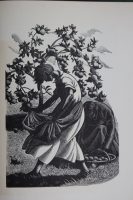 But to happier moments; the thunderstorm that brought down all the windfall apples in September, the opportunities to give away plants, and the joy and wonderment of the abundance of self sown seedlings. How did they get so far from the mother plant?
But to happier moments; the thunderstorm that brought down all the windfall apples in September, the opportunities to give away plants, and the joy and wonderment of the abundance of self sown seedlings. How did they get so far from the mother plant?
All gardeners have artistic sensibility. The plants and flowers are their palette, the earth, rocks and walls their canvass, and the resulting garden, the finished article. Like with so many an artist the work can be endlessly revised and re-imagined. Clare Leighton does this in her garden, but for us that garden lives on in both her prose and even more importantly, her pictures. They were woodcuts that inspired Enid Marx, and its not difficult to see why.
January 17, 2017
January is the time of year to draw in the horns on the garden front and enjoy poring over seed catalogues, in front of the fire. First things first. Find the box containing all of last years seeds whether packets, or little ‘dinner money’ envelopes containing saved seed. Sort through them and decide which reluctantly need to be chucked. ‘Sow by August 2009’ in small type on the back is usually a pretty reliable indicator. So is scrawly handwriting saying ‘pumpkin seed, 2012’ barely readable for the way that slugs have unaccountably crawled all over it and chewed patterns worthy of Jackson Pollock on the packet. Sort through the saveable and the unsaveable; rule of thumb is that anything up to a year out of date is OK. 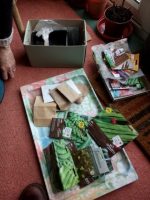 Older than that is generally a risk not worth taking. Lady Muck has a rather more generous (optimistic?) approach.
Older than that is generally a risk not worth taking. Lady Muck has a rather more generous (optimistic?) approach.
Now its time to think about what is to get sown this year; bearing in mind variables like available space, any awkwardly-timed holidays, or successes or disasters of last year that may or may not bear repeating. And then there is the furtleing through the seed packets from last year in the sacred box. An approach probably not unlike that of medieval monks deciding each year which ‘sacred relics’ to to bring out and promote this year to bring the in the pilgrims. ‘Splinter from the True Cross this year guys? Lock of St Aquinas’s hair? Oh my God were running a bit low on original bones from the two fishes, better send an order down to the refectory for a re-stock.’ Nothing changes. Only these days having got the list of required seeds, corms, and tubers for the year sorted, its off to the garden centre rather than a bit of grave robbing in the crypt.
The annual winter ordering seeds from a catalogue is a ritual I have conducted for decades. But as the total area I cultivate has gradually shrunk – fewer mouths to feed and all that, (definitely not the five thousand) the need for dozens of tubers as sent out through the catalogues, has become an expensive and wasteful way to order. So a visit to a local garden shop seems a better bet. Buy what you need. Being in Bristol for a few days and accompanied by Lady Muck we head out to the Henleaze Garden Shop, a veritable emporium of all things to grow, or already growing. A range of potato varieties to die for; and if you want, you can buy just one tuber. In the end we select five, Charlotte, Desiree, Duke of York, Pink Fir Apple and Picasso (eat your heart out Jackson Pollock). The onion sets are equally tempting, Sturon, Stuttgart, Red Baron and a punt with some shallots I don’t know – Yellow Moon. 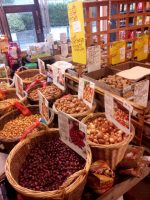 All are carefully counted into bags, just a few of each – such a contrast from the bags of 100+ that came through the post and were mostly wasted. And now to the seeds, and all that hard work in the seed box pays off. The list is relatively short, both a reflection of the smaller growing space these days (a patch in the garden rather grandly known as the potager, a 6ft by 6 ft share of a communal poly tunnel on the allotment, and one large and four small beds amongst the fruit trees on the orchard allotment) and the saved seed supply from last year. There are some stalwarts needed, spinach, lettuce, french beans, beetroot, parsnips, leeks and tomatoes (but plenty of others like cabbage, courgette, broad beans and runner beans are not, as good stocks of last years seed remain) as well as the slightly more exotic like sweet Romano peppers for the poly tunnel. Tomatoes are one of those crops where planting several varieties and in different places; garden, poly tunnel, allotment, greatly reduces the chances of the whole crop getting blight. Packets of seeds are ‘harvested’ and placed with those tubers in the basket.
All are carefully counted into bags, just a few of each – such a contrast from the bags of 100+ that came through the post and were mostly wasted. And now to the seeds, and all that hard work in the seed box pays off. The list is relatively short, both a reflection of the smaller growing space these days (a patch in the garden rather grandly known as the potager, a 6ft by 6 ft share of a communal poly tunnel on the allotment, and one large and four small beds amongst the fruit trees on the orchard allotment) and the saved seed supply from last year. There are some stalwarts needed, spinach, lettuce, french beans, beetroot, parsnips, leeks and tomatoes (but plenty of others like cabbage, courgette, broad beans and runner beans are not, as good stocks of last years seed remain) as well as the slightly more exotic like sweet Romano peppers for the poly tunnel. Tomatoes are one of those crops where planting several varieties and in different places; garden, poly tunnel, allotment, greatly reduces the chances of the whole crop getting blight. Packets of seeds are ‘harvested’ and placed with those tubers in the basket.
When its time to pay we discover the proprietor is trained in horticulture. He saves his own seed and sells the heritage varieties in plugs to get around the regulations on the sale of uncertified seed, and is enjoying running a family business that has been operating for over 70 years. A little snippet of gossip on what is going on at Jekka’s Seeds ensues. So much more fun than ordering from a catalogue. Job done. Home to divide up the packets of seed with far too many in them for most people’s purposes – 500 parsnip seeds anyone? Now its time to start planting …. well, soon.
 I’m very fond of hens and have been keeping them for getting on for 20 years (and indeed kept them as a child), but if you look after them properly they grow old and stop laying eggs. Actually that isn’t quite true. The first hens I had were Warrens the breed created for the intensive laying industry. They are pretty easy to obtain and they are bred to lay and lay and lay for a couple of years and then die. That’s the economic model of the industry. Why pay for the feed and housing of hens that don’t lay? Being new to the game I didn’t know this when I got them. When they predictably, died, I got some pure breeds, a White Sussex a Barred Plymouth Rock and a Rhode Island Red from memory. They were lovely and lived to a great age, ten, not laying an egg between them for about the last two years of their lives and only about 50-60 a year for a couple of years before that. Actually they might well have lived a while longer, but they made the ultimate sacrifice and final contribution to the household economy and after I’d killed them they ended up in the pot. So most recently in 2012 I set off again to the Domestic Fowl Trust then still based outside Pershore for three more. These were crosses of various kinds including a Speckeldy, some kind of Plymouth Rock cross and some kind of Sussex. Six years later the time came round again for the killing spree. No eggs laid since about September and no sign despite the lengthening days, of any more to come. Two more (the third one died about three years ago after being severely frightened by a fox) to add to the statistics – which in the UK alone is in excess of 600 million hens a year slaughtered – yes really. That statistic kind of summarises my position on this. As a vegetarian for the past almost 40 years I’d be a lot a happier about meat eating if people slaughtered it themselves (road kill allowed). I think that might reduce meat consumption quite a bit, helping both the planet and peoples wallets and carbon footprint. To say nothing of animal welfare. But I digress.
I’m very fond of hens and have been keeping them for getting on for 20 years (and indeed kept them as a child), but if you look after them properly they grow old and stop laying eggs. Actually that isn’t quite true. The first hens I had were Warrens the breed created for the intensive laying industry. They are pretty easy to obtain and they are bred to lay and lay and lay for a couple of years and then die. That’s the economic model of the industry. Why pay for the feed and housing of hens that don’t lay? Being new to the game I didn’t know this when I got them. When they predictably, died, I got some pure breeds, a White Sussex a Barred Plymouth Rock and a Rhode Island Red from memory. They were lovely and lived to a great age, ten, not laying an egg between them for about the last two years of their lives and only about 50-60 a year for a couple of years before that. Actually they might well have lived a while longer, but they made the ultimate sacrifice and final contribution to the household economy and after I’d killed them they ended up in the pot. So most recently in 2012 I set off again to the Domestic Fowl Trust then still based outside Pershore for three more. These were crosses of various kinds including a Speckeldy, some kind of Plymouth Rock cross and some kind of Sussex. Six years later the time came round again for the killing spree. No eggs laid since about September and no sign despite the lengthening days, of any more to come. Two more (the third one died about three years ago after being severely frightened by a fox) to add to the statistics – which in the UK alone is in excess of 600 million hens a year slaughtered – yes really. That statistic kind of summarises my position on this. As a vegetarian for the past almost 40 years I’d be a lot a happier about meat eating if people slaughtered it themselves (road kill allowed). I think that might reduce meat consumption quite a bit, helping both the planet and peoples wallets and carbon footprint. To say nothing of animal welfare. But I digress. My experience is just once every 5-6 years. Mind you the phrase ‘headless chicken’ hasn’t passed into the language for no reason. They really do flap around, and if you gave them the chance, run about for a good minute or so. Stone dead, but looking alarmingly alive. Prepping them up for the pot was an eye opener – I’ve always avoided this part of the process in the past. Plucking is made much easier by pouring very hot water over them – the feathers come out real easy then (actually I knew this part as I’d read about it in novels like Edna O’Brien’s ‘The country girls’ – life in the west of Ireland in the 1950’s). Gutting them is a real skill; I wasn’t going anywhere near this part, definitely not ‘Blue Peter’ try-this-one-at-home style. Premier managed to extract all the offal and separated it away for consumption; heart, liver, kidney, gizzard, the lot, with of course the sole exception of the gall bladder which she carefully cut out – bursting that and you spoil the lot. Then to the jointing. Even here nothing is lost. The legs are descaled, and the feet are removed and kept – presumably for soup, there isn’t anything else on them. Ditto the head. Bones are broken and legs, wings and rib cage are reduced to manageable sizes.
My experience is just once every 5-6 years. Mind you the phrase ‘headless chicken’ hasn’t passed into the language for no reason. They really do flap around, and if you gave them the chance, run about for a good minute or so. Stone dead, but looking alarmingly alive. Prepping them up for the pot was an eye opener – I’ve always avoided this part of the process in the past. Plucking is made much easier by pouring very hot water over them – the feathers come out real easy then (actually I knew this part as I’d read about it in novels like Edna O’Brien’s ‘The country girls’ – life in the west of Ireland in the 1950’s). Gutting them is a real skill; I wasn’t going anywhere near this part, definitely not ‘Blue Peter’ try-this-one-at-home style. Premier managed to extract all the offal and separated it away for consumption; heart, liver, kidney, gizzard, the lot, with of course the sole exception of the gall bladder which she carefully cut out – bursting that and you spoil the lot. Then to the jointing. Even here nothing is lost. The legs are descaled, and the feet are removed and kept – presumably for soup, there isn’t anything else on them. Ditto the head. Bones are broken and legs, wings and rib cage are reduced to manageable sizes.  Thirty minutes or so later there was 2.5kg of edible (in one form or another) chicken from each bird and waste amounting to half a cup full from the pair of them. Now that is the way to honour their lives. Thank you dear hens; you were great company, an ornament in the garden, delightfully productive in your lives, and equally so in your deaths. May your souls soar and when I come to eat you I will raise a glass to your memory.
Thirty minutes or so later there was 2.5kg of edible (in one form or another) chicken from each bird and waste amounting to half a cup full from the pair of them. Now that is the way to honour their lives. Thank you dear hens; you were great company, an ornament in the garden, delightfully productive in your lives, and equally so in your deaths. May your souls soar and when I come to eat you I will raise a glass to your memory.



















